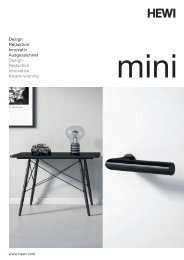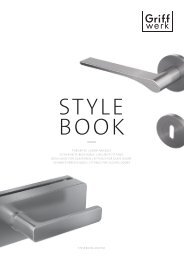- Page 1:
Manual No. 14 Door and window hardw
- Page 5 and 6:
Contents 2 6 8 10 12 14 32 38 43 44
- Page 7:
Introduction 1 Good architecture is
- Page 10 and 11:
Made in Brakel, Germany It's in you
- Page 12 and 13:
The FSB DNA Quality you can touch Q
- Page 14 and 15:
FSB Handmade Your ideas take shape
- Page 16 and 17:
FSB Care Our experience - your safe
- Page 18 and 19:
Materials and finishes High-class m
- Page 20 and 21:
Materials and finishes Aluminium FS
- Page 22 and 23:
Materials and finishes Blasted alum
- Page 24 and 25:
Materials and finishes Aluminium +
- Page 26 and 27:
Materials and finishes Stainless St
- Page 28 and 29:
Materials and finishes Bronze FSB 7
- Page 30 and 31:
Materials and finishes Bronze fitti
- Page 32 and 33:
Materials and finishes Bronze fitti
- Page 34 and 35:
Materials and finishes Bronze fitti
- Page 36 and 37:
32 FSB Manual No. 14
- Page 39 and 40:
Bathroom hardware ErgoSystem® A100
- Page 41 and 42:
FSB ErgoSystem®: unparalleled comf
- Page 43 and 44:
2 2 1 Flexibility With A-Flex, FSB
- Page 45 and 46:
Seats Suspended seats Tip-up shower
- Page 47 and 48:
Bathroom hardware METRIC® Overview
- Page 49 and 50:
2 1 2 3 4 5 6 7 8 the assembly proc
- Page 51:
Shower rails Shower rails Shower at
- Page 55 and 56:
Bearing and adaptor technology 3 52
- Page 57 and 58:
The FSB adaptor system is not a bea
- Page 59 and 60:
Turnably fixed adaptor Transferring
- Page 61 and 62:
Turnably fixed adaptor Low-friction
- Page 63:
Heavy-duty version The FSB AGL® is
- Page 66 and 67:
Technical information EN 1906 fitti
- Page 68:
Technical information EN 1906 fitti
- Page 73 and 74:
Product collections 4 70 72 76 315
- Page 75 and 76:
Around 50 different door handle mod
- Page 77 and 78:
FSB 1004 | 1134 Composition of FSB
- Page 79 and 80:
Handing details Doors can be hung t
- Page 81 and 82:
Heavy-duty FSB Select Aluminium Sta
- Page 83 and 84:
Heavy-duty FSB Select Aluminium Sta
- Page 85 and 86:
Lever handle with privacy function
- Page 87 and 88:
Glass door fitting 13 4220 with 10
- Page 89 and 90:
Lever/knob sets Broad backplate set
- Page 91 and 92:
Lever handle with privacy function
- Page 93 and 94:
WC sets 12 1003 045 (N) Broad backp
- Page 95 and 96:
Lever handle with privacy function
- Page 97 and 98:
Glass door fitting 13 4220 with 72
- Page 99 and 100:
Lever/knob sets Broad backplate set
- Page 101 and 102:
Lever handle with privacy function
- Page 103 and 104:
Glass door fitting 13 4220 with 12
- Page 105 and 106:
Lever/knob sets 12 1005 017 (N) Bro
- Page 107 and 108:
Lever handle with privacy function
- Page 109 and 110:
Glass door fitting 13 4220 with 72
- Page 111 and 112:
Lever/knob sets Broad backplate set
- Page 113 and 114:
Lever handle with privacy function
- Page 115 and 116:
Glass door fitting 13 4220 with 72
- Page 117 and 118:
Lever/knob sets Broad backplate set
- Page 119 and 120:
Lever handle with privacy function
- Page 121 and 122:
WC sets 12 1021 019 (N) Broad backp
- Page 123 and 124:
Lever handle with privacy function
- Page 125 and 126:
Glass door fitting 13 4223 with 72
- Page 127 and 128:
Lever/knob sets Broad backplate set
- Page 129 and 130:
Lever handle with privacy function
- Page 131 and 132:
Glass door fitting 13 4220 with 10
- Page 133 and 134:
Lever/knob sets Broad backplate set
- Page 135 and 136:
Lever handle with privacy function
- Page 137 and 138:
Glass door fitting 13 4223 with 72
- Page 139 and 140:
Lever/knob sets Broad backplate set
- Page 141 and 142:
Lever handle with privacy function
- Page 143 and 144:
WC sets 12 1051 019 (N) 15 1051 019
- Page 145 and 146:
Lever handle with privacy function
- Page 147 and 148:
WC sets 12 1058 019 (N) 15 1058 019
- Page 149 and 150:
Lever handle with privacy function
- Page 151 and 152:
Glass door fitting 13 4223 with 72
- Page 153 and 154:
Lever/knob sets Broad backplate set
- Page 155 and 156:
Lever handle with privacy function
- Page 157 and 158:
WC sets 12 1075 019 (N) Broad backp
- Page 159 and 160:
Lever handle with privacy function
- Page 161 and 162:
Glass door fitting 13 4220 with 72
- Page 163 and 164:
Lever/knob sets Broad backplate set
- Page 165 and 166:
Lever handle with privacy function
- Page 167 and 168:
Glass door fitting 13 4220 with 10
- Page 169 and 170:
Lever/knob sets Broad backplate set
- Page 171 and 172:
Lever handle with privacy function
- Page 173 and 174:
Glass door fitting 13 4223 with 72
- Page 175 and 176:
Lever/knob sets Broad backplate set
- Page 177 and 178:
Lever handle with privacy function
- Page 179 and 180:
Glass door fitting 13 4220 with 10
- Page 181 and 182:
Lever/knob sets Broad backplate set
- Page 183 and 184:
Lever handle with privacy function
- Page 185 and 186:
Glass door fitting 13 4223 with 72
- Page 187 and 188:
Lever/knob sets Broad backplate set
- Page 189 and 190:
Lever handle with privacy function
- Page 191 and 192:
Glass door fitting 13 4223 with 72
- Page 193 and 194:
Lever/knob sets Broad backplate set
- Page 195 and 196:
Lever handle with privacy function
- Page 197 and 198:
Glass door fitting 13 4223 with 72
- Page 199 and 200:
Lever/knob sets Broad backplate set
- Page 201 and 202:
Lever handle with privacy function
- Page 203 and 204:
Glass door fitting 13 4223 with 72
- Page 205 and 206:
Lever/knob sets Broad backplate set
- Page 207 and 208:
Lever handle with privacy function
- Page 209 and 210:
WC sets 10 1135 | 14 1425 17554 15
- Page 211 and 212:
Lever handle with privacy function
- Page 213 and 214:
Glass door fitting 13 4223 with 72
- Page 215 and 216:
Lever/knob sets Broad backplate set
- Page 217 and 218:
Lever handle with privacy function
- Page 219 and 220:
Glass door fitting 13 4223 with 72
- Page 221 and 222:
Lever/knob sets Broad backplate set
- Page 223 and 224:
Lever handle with privacy function
- Page 225 and 226:
Glass door fitting 13 4223 with 72
- Page 227 and 228:
Lever/knob sets Broad backplate set
- Page 229 and 230:
Lever handle with privacy function
- Page 231 and 232:
Glass door fitting 13 4223 with 10
- Page 233 and 234:
Lever/knob sets Broad backplate set
- Page 235 and 236:
Lever handle with privacy function
- Page 237 and 238:
Glass door fitting 13 4223 with 72
- Page 239 and 240:
Lever/knob sets Broad backplate set
- Page 241 and 242:
Lever handle with privacy function
- Page 243 and 244:
Glass door fitting 13 4220 with 72
- Page 245 and 246:
Lever/knob sets Broad backplate set
- Page 247 and 248:
Lever handle with privacy function
- Page 249 and 250:
WC sets 12 1176 019 (N) Broad backp
- Page 251 and 252:
Lever handle with privacy function
- Page 253 and 254:
Glass door fitting 13 4220 with 10
- Page 255 and 256:
Lever/knob sets Broad backplate set
- Page 257 and 258:
Lever handle with privacy function
- Page 259 and 260:
WC sets Broad backplate sets availa
- Page 261 and 262:
Lever handle with privacy function
- Page 263 and 264:
Glass door fitting 13 4220 with 72
- Page 265 and 266:
Lever/knob sets Broad backplate set
- Page 267 and 268:
Lever handle with privacy function
- Page 269 and 270:
WC sets 12 1241 019 (N) Broad backp
- Page 271 and 272:
Lever handle with privacy function
- Page 273 and 274:
Glass door fitting 13 4220 with 10
- Page 275 and 276:
Lever/knob sets Broad backplate set
- Page 277 and 278:
Lever handle with privacy function
- Page 279 and 280:
Glass door fitting 13 4220 with 72
- Page 281 and 282:
Lever/knob sets Broad backplate set
- Page 283 and 284:
Lever handle with privacy function
- Page 285 and 286:
Glass door fitting 13 4223 with 72
- Page 287 and 288:
Lever/knob sets Broad backplate set
- Page 289 and 290:
Lever handle with privacy function
- Page 291 and 292:
WC sets 12 1251 045 (N) Broad backp
- Page 293 and 294:
Lever handle with privacy function
- Page 295 and 296:
Glass door fitting 13 4220 with 72
- Page 297 and 298:
Lever/knob sets Broad backplate set
- Page 299 and 300:
Lever handle with privacy function
- Page 301 and 302:
Glass door fitting 13 4223 with 72
- Page 303 and 304:
Lever/knob sets Broad backplate set
- Page 305 and 306:
Lever handle with privacy function
- Page 307 and 308:
Glass door fitting 13 4220 with 10
- Page 309 and 310:
Lever/knob sets Broad backplate set
- Page 311 and 312:
Lever handle with privacy function
- Page 313 and 314:
Glass door fitting 13 4220 with 10
- Page 315 and 316:
Lever/knob sets Broad backplate set
- Page 317:
Numbers and number holder 38 4006 0
- Page 320:
Technical information WC roses WC s
- Page 323:
Customised product configuration 5
- Page 326 and 327:
Customised product configuration FS
- Page 328 and 329:
Customised product configuration FS
- Page 331 and 332:
327 FSB ASL® kit
- Page 333 and 334:
Aluminium Stainless steel Bronze Do
- Page 335 and 336:
FSB ASL® kit Square roses Aluminiu
- Page 337 and 338:
FSB ASL® kit Oval backplates Alumi
- Page 339 and 340:
FSB ASL® kit Angular backplates Al
- Page 341 and 342:
FSB ASL® kit Oval knob backplates
- Page 343 and 344:
FSB ASL® kit Doorknobs for back-to
- Page 345 and 346:
FSB ASL® kit Doorknobs for back-to
- Page 347 and 348:
FSB ASL® kit Doorknobs for back-to
- Page 349 and 350:
FSB ASL® kit Doorknobs for back-to
- Page 351 and 352:
FSB ASL® kit Female knob handles A
- Page 353 and 354:
FSB ASL® kit Accessory bags for sh
- Page 355:
FSB ASL® kit Accessory bags for le
- Page 358 and 359:
FSB roses and backplates kit Overvi
- Page 360 and 361:
FSB roses and backplates kit Overvi
- Page 362 and 363:
FSB roses and backplates kit Oval b
- Page 364 and 365:
FSB roses and backplates kit Broad
- Page 366 and 367:
FSB roses and backplates kit Cut ro
- Page 368 and 369:
FSB roses and backplates kit Cut ba
- Page 370 and 371:
FSB roses and backplates kit Backpl
- Page 372 and 373:
FSB roses and backplates kit Round,
- Page 374 and 375:
FSB roses and backplates kit Knob b
- Page 376 and 377:
FSB roses and backplates kit Roses
- Page 378 and 379:
FSB roses and backplates kit Securi
- Page 380 and 381:
FSB roses and backplates kit Doorkn
- Page 382 and 383:
FSB roses and backplates kit Doorkn
- Page 384 and 385:
FSB roses and backplates kit Female
- Page 386 and 387:
FSB roses and backplates kit Lockab
- Page 389 and 390:
385 Technical information Customise
- Page 391 and 392:
Technical information Roses and bac
- Page 393 and 394:
Technical information Backplates Ba
- Page 395:
Technical information Flush-fitted
- Page 399 and 400:
Fittings for doors and windows 6a 3
- Page 401 and 402:
PIV certification under EN 1906, gr
- Page 403 and 404:
For the complete product code, simp
- Page 405:
Aluminium Stainless steel Bronze 15
- Page 408 and 409:
Technical information Plug-in handl
- Page 411 and 412:
Fittings for doors and windows 6b 4
- Page 413 and 414:
Click-stop mechanism ensures tangib
- Page 415 and 416:
For the complete product code, simp
- Page 418 and 419:
Fittings for windows Overview Windo
- Page 420 and 421:
Fittings for windows Overview Windo
- Page 422 and 423:
Fittings for windows Overview Tee h
- Page 424 and 425:
Fittings for windows Overview Lifti
- Page 426 and 427:
Fittings for windows Tee handles fo
- Page 428 and 429:
Fittings for windows Tee handles fo
- Page 430 and 431:
Fittings for windows Window handles
- Page 432 and 433:
Fittings for windows Lockable windo
- Page 434 and 435:
Fittings for windows Lockable windo
- Page 436 and 437:
Fittings for windows Lockable windo
- Page 438 and 439:
Fittings for windows Lockable windo
- Page 440 and 441:
Fittings for windows Lockable windo
- Page 442 and 443:
Fittings for windows Budget lock ro
- Page 444 and 445:
Fittings for windows Parallel slide
- Page 446 and 447:
Fittings for windows Lifting/slidin
- Page 448 and 449:
Fittings for windows Lifting/slidin
- Page 450 and 451:
Fittings for windows Lifting/slidin
- Page 452 and 453:
Fittings for windows Lifting/slidin
- Page 454:
Fittings for windows Recessed handl
- Page 458 and 459:
Technical information Fittings for
- Page 460 and 461:
Technical information Fittings for
- Page 462 and 463:
Technical information Fixing system
- Page 464 and 465:
Technical information Fixing system
- Page 467 and 468:
Fittings for doors and windows 6c 4
- Page 469 and 470:
1.5 million operating cycles tested
- Page 471 and 472:
For the complete product code, simp
- Page 473 and 474:
Product features of lever handles f
- Page 475 and 476:
Aluminium Stainless steel Bronze 06
- Page 477 and 478:
Aluminium Stainless steel Bronze Ba
- Page 479 and 480:
Aluminium Stainless steel Bronze Do
- Page 481 and 482:
Fittings for narrow-stile doors Lev
- Page 483 and 484:
Fittings for narrow-stile doors Doo
- Page 485 and 486:
Fittings for narrow-stile doors Doo
- Page 487 and 488:
Fittings for narrow-stile doors Doo
- Page 489 and 490:
Fittings for narrow-stile doors Sli
- Page 491:
Fittings for narrow-stile doors Lev
- Page 494 and 495:
Technical information Fittings for
- Page 496 and 497:
Technical information Fittings for
- Page 498 and 499:
Technical information Spindles for
- Page 501 and 502:
Fittings for doors and windows 6d 4
- Page 503 and 504:
Fittings with consistent design for
- Page 505 and 506:
Heavy-duty variant Glass door fitti
- Page 507 and 508:
Aluminium Stainless steel Bronze Gl
- Page 509 and 510:
Fittings for glass doors Compact st
- Page 511 and 512:
Fittings for glass doors Strike box
- Page 513 and 514:
Fittings for glass doors Glass-door
- Page 515 and 516:
Fittings for glass doors Glass-door
- Page 517 and 518:
Fittings for glass doors Glass-door
- Page 519 and 520:
Fittings for glass doors Round glas
- Page 521 and 522:
Fittings for glass doors Doorknobs
- Page 523:
Fittings for glass doors Sliding do
- Page 526 and 527:
Technical information Glass door me
- Page 528 and 529:
Technical information Receivers for
- Page 531 and 532:
Fittings for doors and windows 6e 5
- Page 533 and 534:
Emergency release device on the out
- Page 535 and 536:
For the complete product code, simp
- Page 537:
Aluminium Stainless steel Bronze 11
- Page 540 and 541:
Flush-fitted hardware Product varia
- Page 542 and 543:
Flush-fitted hardware Flush-fitted
- Page 544 and 545:
540 FSB Manual No. 14
- Page 547 and 548:
Fittings for special-function doors
- Page 549 and 550:
Simple and tool-free installation:
- Page 551 and 552:
Product features of sliding door ha
- Page 553 and 554:
Aluminium Stainless steel Bronze Sl
- Page 555 and 556:
Fittings for sliding doors Rectangu
- Page 557 and 558:
Fittings for sliding doors Square s
- Page 559 and 560:
Fittings for sliding doors Sliding
- Page 561 and 562:
Fittings for sliding doors Sliding
- Page 563 and 564:
Fittings for sliding doors Sliding-
- Page 565 and 566:
Fittings for sliding doors Mortise
- Page 567 and 568:
Fittings for sliding doors Angular
- Page 569 and 570:
Fittings for sliding doors Round sl
- Page 573 and 574:
569 Technical information Fittings
- Page 575 and 576:
Technical information Routing dimen
- Page 577 and 578:
Technical information Routing dimen
- Page 579:
Technical information Routing dimen
- Page 582 and 583:
Recessed lever handles Added value
- Page 584:
Recessed lever handles Overview Alu
- Page 587 and 588:
Recessed lever handles conforming t
- Page 589 and 590:
Recessed lever handles With corner
- Page 591:
Recessed lever handles Flush ring h
- Page 594 and 595:
Fittings for emergency exit and pan
- Page 596 and 597:
Fittings for emergency exit and pan
- Page 598 and 599:
Fittings for emergency exit and pan
- Page 600 and 601:
Fittings for emergency exit and pan
- Page 602 and 603:
Fittings for emergency exit and pan
- Page 604 and 605:
Fittings for emergency exit and pan
- Page 606 and 607:
36 50 Fittings 58 for emergency exi
- Page 608 and 609:
Fittings for emergency exit and pan
- Page 610 and 611:
Fittings for emergency exit and pan
- Page 613 and 614:
609 Technical information Fittings
- Page 615:
Technical information EN 179 for em
- Page 618 and 619:
XXL door handles Added value at a g
- Page 620:
XXL door handles Overview Aluminium
- Page 623 and 624:
XXL door handles FSB 1118 | FSB 111
- Page 625 and 626:
XXL door handles FSB 1287 Aluminium
- Page 627:
XXL door handles Barrier-free fitti
- Page 631 and 632:
Entrance door hardware 8a 626 634 6
- Page 633 and 634:
In addition to door pulls, FSB offe
- Page 635 and 636:
Aluminium Stainless steel Bronze Do
- Page 637 and 638:
Aluminium Stainless steel Bronze Do
- Page 639 and 640:
Fittings for entrance doors Push/pu
- Page 641 and 642:
Fittings for entrance doors Push/pu
- Page 643 and 644:
Fittings for entrance doors Order f
- Page 645 and 646:
Fittings for entrance doors Order f
- Page 647 and 648:
Fittings for entrance doors Angular
- Page 649 and 650:
Fittings for entrance doors Oval do
- Page 651 and 652:
Fittings for entrance doors Oval do
- Page 653 and 654:
Fittings for entrance doors Oval do
- Page 655 and 656:
Fittings for entrance doors Oval do
- Page 657 and 658:
Fittings for entrance doors Oval ht
- Page 659 and 660:
Fittings for entrance doors Door-pu
- Page 661 and 662:
Fittings for entrance doors Round d
- Page 663 and 664:
Fittings for entrance doors Round d
- Page 665 and 666:
Fittings for entrance doors Order f
- Page 667 and 668:
Fittings for entrance doors Round d
- Page 669 and 670:
Fittings for entrance doors Order f
- Page 671 and 672:
Fittings for entrance doors Order f
- Page 673 and 674:
Fittings for entrance doors Round d
- Page 675 and 676:
Fittings for entrance doors Round d
- Page 677 and 678:
Fittings for entrance doors Round d
- Page 679 and 680:
Fittings for entrance doors Order f
- Page 681 and 682:
Fittings for entrance doors Door pu
- Page 683 and 684:
Fittings for entrance doors Door-pu
- Page 685 and 686:
Fittings for entrance doors Half-ro
- Page 687 and 688:
Fittings for entrance doors Half-se
- Page 689 and 690:
Fittings for entrance doors Half-se
- Page 691:
Fittings for entrance doors Letter
- Page 694 and 695:
Technical information Door pulls Qu
- Page 696 and 697:
Technical information Drilling dime
- Page 698 and 699:
Technical information Fixing door p
- Page 700 and 701:
Technical information Fixing door p
- Page 702 and 703:
Technical information Fixing door p
- Page 704:
Technical information Letter plates
- Page 708 and 709:
Door pulls with Fingerscan Added va
- Page 710 and 711:
Door pulls with Fingerscan Round FS
- Page 712 and 713:
Door pulls with Fingerscan Round FS
- Page 714 and 715:
Door pulls with Fingerscan Round FS
- Page 717 and 718:
Entrance door hardware 8c 712 720 7
- Page 719 and 720:
Certified under EN 1906 or DIN 1825
- Page 721 and 722:
For the complete product code, simp
- Page 723 and 724:
Aluminium Stainless steel Bronze Se
- Page 725 and 726:
Security fittings Backplate set Alu
- Page 727 and 728:
Security fittings Short backplate s
- Page 729 and 730:
Security fittings Long backplate se
- Page 731 and 732:
Security fittings Long backplate se
- Page 733 and 734:
Security fittings Long backplate se
- Page 735 and 736: Security fittings Long backplate se
- Page 737 and 738: Security fittings Long backplate se
- Page 739 and 740: Security fittings Sets for narrow-s
- Page 741 and 742: Security fittings Security roses fo
- Page 743 and 744: Security fittings Security roses fo
- Page 745: Security fittings Flush-fitted secu
- Page 748 and 749: Technical information Security fitt
- Page 750: Technical information Flush-fitted
- Page 755 and 756: Accessories 9a 750 Door stops
- Page 757: Door stops Aluminium Stainless stee
- Page 760 and 761: Spindles, fixing material and acces
- Page 762 and 763: Spindles, fixing material and acces
- Page 764 and 765: Spindles, fixing material and acces
- Page 766 and 767: Spindles, fixing material and acces
- Page 768 and 769: Spindles, fixing material and acces
- Page 770 and 771: Spindles, fixing material and acces
- Page 772 and 773: Spindles, fixing material and acces
- Page 774 and 775: Spindles, fixing material and acces
- Page 777 and 778: Accessories 9c 772 Routing jigs and
- Page 779 and 780: Routing jigs and fixing equipment U
- Page 781 and 782: Routing jigs and fixing equipment T
- Page 783 and 784: Routing jigs and fixing equipment T
- Page 785: Routing jigs and fixing equipment R
- Page 789 and 790: Routing jigs and fixing equipment T
- Page 791: Routing jigs and fixing equipment T
- Page 794 and 795: Appendix FSB contact persons + loca
- Page 796 and 797: Appendix General index Flexible/dep
- Page 798 and 799: Appendix Index of product groups 03
- Page 800 and 801: Appendix Product code index Product
- Page 802: Appendix Product code index Product
















